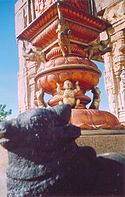
 The Brihadeswara temple is one of the most ancient and the most celebrated Hindu temple in the world.The temple is located in the city of Thanjavur that is also known as Tanjore, in the Indian province of Tamilnadu. The UNESCO has adjudged this thousand years old temple a "World Heritage Site".
The Brihadeswara temple is one of the most ancient and the most celebrated Hindu temple in the world.The temple is located in the city of Thanjavur that is also known as Tanjore, in the Indian province of Tamilnadu. The UNESCO has adjudged this thousand years old temple a "World Heritage Site".
Brihadeswara is the most illustrious and a brilliant example of the Dravidian style temple architecture. The building that carries the main sanctum is known as the 'Periya Kovil'. This stands amidst fortified walls that were probably added in the 16th century.The 'Vimana' of the temple is about 70 meters and is among the tallest of its kind in the world. The 'Shikharam' (crown) of Brihadeswara temple is itself very large and heavy (81.25 tons) and has been carved out of a single stone.
The great Tamil ruler, Rajaraja Chola I of the Chola dynasty, built the Brihadeswara temple. Later various additions were made in the temple but the most prominent one among these was the addition of a copper pot over the tower by King Rajaraja Chola II. The main deity that is worshiped in this temple is Lord Shiva. .He is worshipped in the form of Lingam. This was originally called Adavallan that meant an expert dancer. The same name occurs in Thiruvisaipa as the name of the deity at Chidambaram. The tower over the shrine is named Dakshina Meru after the abode of Lord Shiva at Kailash that is also called Meru Mountain in Hindu scriptures.
An axial and symmetrical geometry rules the temple layout. Temples from this period and the following two centuries are an expression of the Chola wealth, power and artistic expertise. The emergence of such features as the multifaceted columns with projecting square capitals signal the arrival of the new Chola style.
 The Brihadishwara Temple was built to be the royal temple to display the emperor's vision of his power and his relationship to the universal order. .The temple was the site of the major royal ceremonies such as anointed the emperor and linking him with its deity, Shiva, and the daily rituals of the deities were mirrored by those of the king. The temple maintained a staff of 600 people in various capacities.
The Brihadishwara Temple was built to be the royal temple to display the emperor's vision of his power and his relationship to the universal order. .The temple was the site of the major royal ceremonies such as anointed the emperor and linking him with its deity, Shiva, and the daily rituals of the deities were mirrored by those of the king. The temple maintained a staff of 600 people in various capacities.
 The temple complex sits on the banks of a river that was channeled to make a moat around the complex's outer walls, the walls being built like a fortress. The complex is made up of many structures that are aligned axially. .The complex can be entered either on one axis through a five-story gopuram with a second access directly to the huge main quadrangle through a smaller free-standing gopuram. The massive size of the main sikhara (although it is hollow on the inside and not meant to be occupied), is 63 meters in height, with 16 severely articulated stories, and dominates the main quadrangle. Pilaster, piers, and attached columns are placed rhythmically covering every surface of the shikhara.
The temple complex sits on the banks of a river that was channeled to make a moat around the complex's outer walls, the walls being built like a fortress. The complex is made up of many structures that are aligned axially. .The complex can be entered either on one axis through a five-story gopuram with a second access directly to the huge main quadrangle through a smaller free-standing gopuram. The massive size of the main sikhara (although it is hollow on the inside and not meant to be occupied), is 63 meters in height, with 16 severely articulated stories, and dominates the main quadrangle. Pilaster, piers, and attached columns are placed rhythmically covering every surface of the shikhara.
Another remarkable feature of the temple is the great Nandi (stone bull) that is established at the entrance of the temple as well as ceiling of its enclosure that is decorated with frescoes in the typical Thanjavur style of painting. The Nandi weighs 27 tons and is probably the largest of its kind in the world.
This temple is one of India's most prized architectural sites. The temple stands amidst fortified walls that were probably added in the 16th century.
